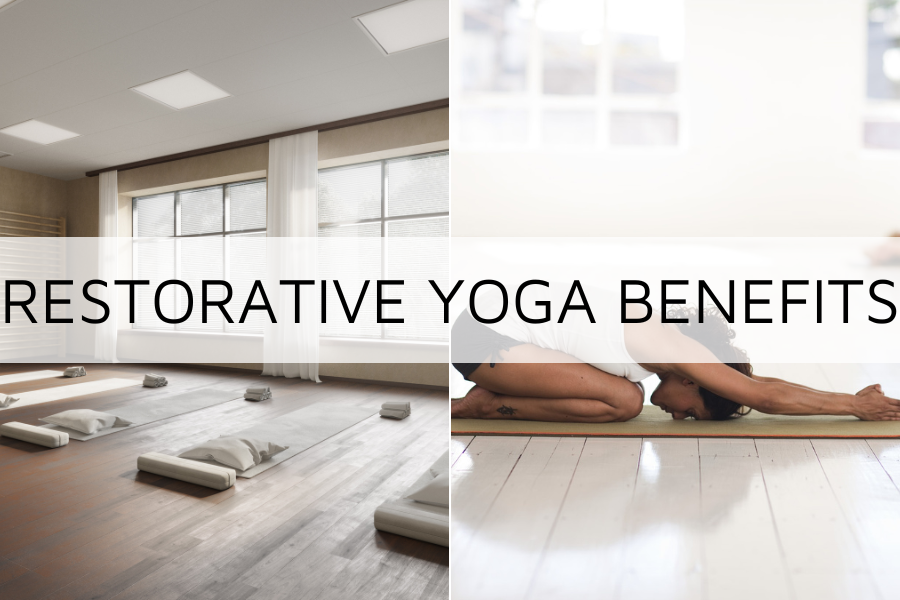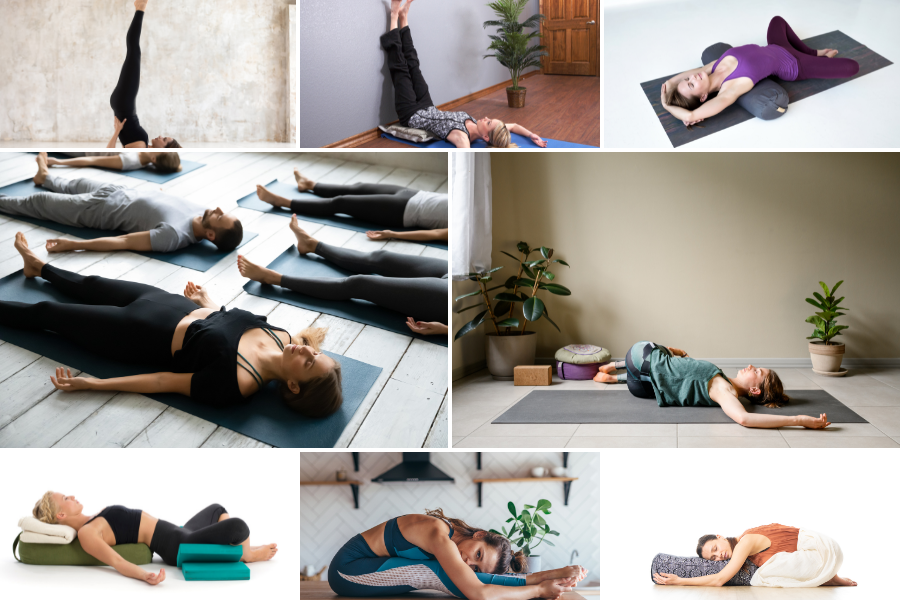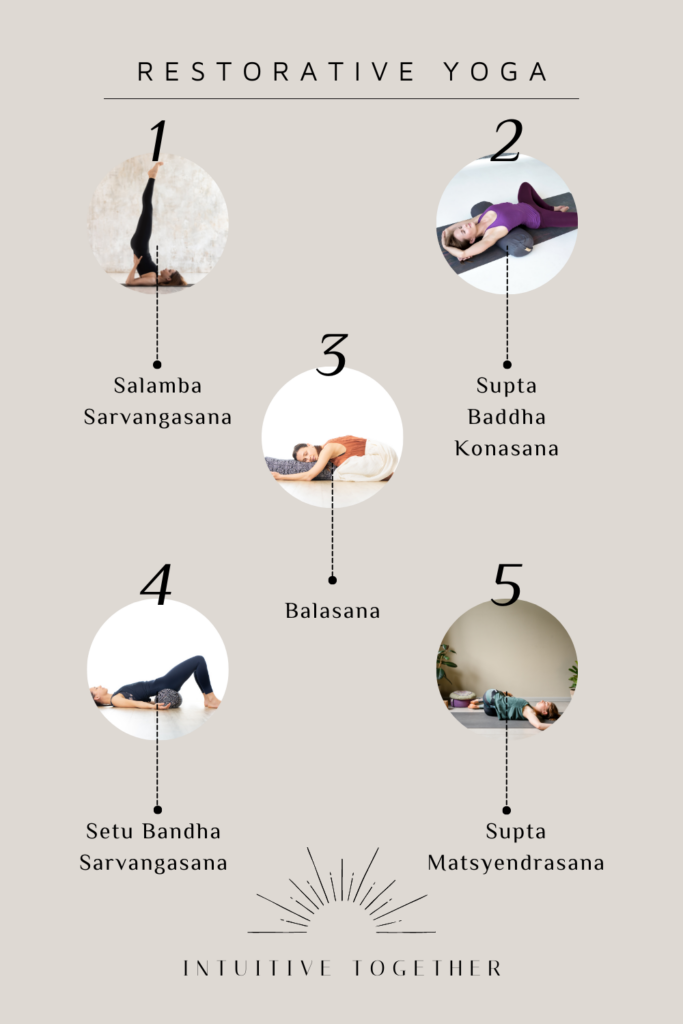Top 10 Restorative Yoga Benefits: The Power of Slowing Down
Want to discover 10 powerful restorative yoga benefits? Today we’ll discuss the healing nature of slowing down, and how it balances the nervous system.

Restorative yoga has a number of incredible health benefits. It’s one of the few clinically proven ways to self regulate the nervous system. It’s exceptionally beneficial for trauma survivors,those who struggle with eating disorders, as well as drastically reduces stress.
In this article, we’ll dive deeper into the restorative yoga health benefits, restorative yoga poses, how often you should practice restorative yoga, and how it balances the nervous system.
This article is about restorative yoga benefits.
Restorative Yoga Benefits
What is restorative yoga?
Restorative yoga is a gentle and therapeutic style of yoga that focuses on relaxation, deep rest, and cultivating inner tranquility. It involves holding passive yoga poses for an extended period, typically ranging from 5 to 20 minutes or even longer. Unlike more active yoga practices that involve dynamic movements and muscular engagement, restorative yoga emphasizes stillness and supported poses using props such as blankets, bolsters, pillows, blocks, and straps. For some yogis, the nature of restorative yoga is significantly more challenging than Hatha or Vinyasa because a ton of sensations emerge from staying still. While others call it “an adult nap time”.
The primary goal of restorative yoga is to create a state of physical, mental, and emotional balance. It allows the body and mind to enter a state of deep stillness, activating the parasympathetic nervous system, which is responsible for digest, relaxation, and healing. Living in a society that is built on the grounds of instant and fast, taking the time to remain present and stationary is incredibly therapeutic. By supporting the body with yoga props, restorative yoga encourages muscular release, rearranging the fascia, slowing the breath, and a general sense of calm. Can you remain and not run from the sensations or thoughts that emerge? That’s the goal.
The yoga poses typically include gentle twists, forward folds, gentle backbends, and inversions, among others. These poses are often modified to accommodate individual needs and limitations, making it accessible to people of all fitness levels and physical abilities.
During a restorative yoga practice, the emphasis is on surrendering to gravity and fully relaxing into each pose. The practice also encourages mindful awareness and a sense of introspection. It is an opportunity to tune into the present moment, and cultivate self-care and self-nurturing.
Restorative yoga is beneficial for individuals experiencing stress, fatigue, anxiety, chronic pain, or recovering from injuries. It helps to reduce stress hormones, improve sleep quality, enhance flexibility, and support the body’s natural healing processes. It also offers a space for emotional healing and inner reflection. Which is highly beneficial in healing trauma. Some poses can even assist in trauma release stored in connective tissues (the fascia). It also reconnects your mind and soul to your body, which assists with dissociation, body dysmorphia, and eating disorders.
Restorative yoga can be practiced on its own as a dedicated session or as a complement to a more active yoga practice or exercise routine. It is often recommended to incorporate restorative yoga into one’s self-care routine, especially during times of increased stress or when the body and mind require deep relaxation and restoration.
It’s important to note that restorative yoga should be practiced under the guidance of a qualified instructor( <–my favorite instructors, here’s a free 30 day pass to try), especially if you are new to yoga or have specific health concerns. An instructor can provide guidance on proper alignment, pose modifications, and help create a safe and nurturing environment for your practice.
My favorite props:
10 Restorative Yoga Benefits:
We’ve already covered a few of the restorative yoga benefits, and there are countless benefits you’ll discover once you start practicing. Here is a more in-depth look at the top 10 restorative yoga benefits:
- Deep Relaxation: Restorative yoga induces a state of deep relaxation, allowing the body and mind to release tension and stress. It activates the relaxation response, reducing the production of stress hormones and promoting a sense of calm and tranquility.
- Stress Relief: Restorative yoga is a powerful tool for managing stress. By slowing down and engaging in gentle, supported poses, you can activate the body’s response to let go, reduce anxiety, and find relief from the demands of daily life.
- Improved Flexibility: Restorative yoga gently stretches the muscles and fascia promoting increased flexibility and range of motion. The prolonged holds in supported poses encourage the gradual release of tension and help lengthen and elongate the muscles over time.
- Enhanced Body Awareness: Through the practice of restorative yoga, you develop a heightened sense of body awareness. By paying attention to sensations, breath, and the present moment, you cultivate a deeper connection with your body and gain insights into areas of tension or imbalance. Vital for those who experienced trauma, body dysmorphia, or dissociation.
- Boosted Immune System: Restorative yoga has been shown to support the immune system by reducing stress and promoting relaxation. Chronic stress weakens the immune system, so engaging in restorative practices can help strengthen your body’s natural defense mechanisms.
- Improved Sleep Quality: The deep relaxation and calming nature of restorative yoga can contribute to improved sleep quality. By practicing restorative poses before bedtime, you can unwind, quiet the mind, and create the optimal conditions for a restful night’s sleep.
- Pain Relief: Restorative yoga can provide relief from chronic pain and discomfort. By supporting the body in comfortable positions, you allow the muscles and joints to relax, reduce inflammation, and alleviate pain associated with conditions such as arthritis or fibromyalgia.
- Emotional Healing: Restorative yoga offers a nurturing space for emotional healing and self-reflection. The practice encourages self-care, introspection, and a sense of inner peace. It can help reduce symptoms of anxiety and depression, and promote emotional well-being. Don’t be surprised if you start crying during a session, it’s totally natural.
- Mindfulness and Clarity: Restorative yoga cultivates mindfulness and present-moment awareness. By focusing on the breath and sensations in the body, you can quiet the mind, reduce mental chatter, and attain a sense of mental clarity and inner stillness.
- Balancing the Nervous System: Restorative yoga helps balance the autonomic nervous system by shifting from the sympathetic (“fight-or-flight”) mode to the parasympathetic (“rest-and-digest”) mode. This balance is crucial for overall well-being, as it supports digestion, immunity, and the body’s natural healing processes.
Remember, individual experiences may vary, and it’s important to listen to your body and consult with a qualified instructor or healthcare professional if you have specific health concerns or limitations.
How often you should practice restorative yoga
The frequency of restorative yoga practice can vary depending on individual needs, schedules, and preferences. However, incorporating regular restorative yoga sessions into your routine can provide consistent benefits for your overall well-being. Here are some general guidelines to consider:
- Consistency is Key: Aim to practice restorative yoga consistently rather than sporadically. Regular practice allows your body and mind to become familiar with the relaxation response and deepen your ability to rest and restore.
- Start with a Realistic Schedule: Begin by incorporating one or two restorative yoga sessions per week into your routine. This will allow you to establish a habit and experience the benefits of the practice.
- Gradually Increase Frequency: As you become more comfortable and familiar with restorative yoga, you can gradually increase the frequency of your practice. You may choose to practice three to four times a week or even incorporate shorter daily sessions if your schedule permits.
- Listen to Your Body: Pay attention to how your body and mind respond to the practice. If you feel energized, rejuvenated, and balanced after a restorative yoga session, it’s a good sign that you’re benefiting from it. On the other hand, if you feel fatigued or overwhelmed, you may need to adjust the frequency or duration of your practice.
- Modify According to Your Needs: Adapt your restorative yoga practice based on your lifestyle, stress levels, and other physical activities. For instance, during particularly busy or stressful periods, you might prioritize more frequent restorative sessions to help manage stress and maintain balance.
- Seek Professional Guidance: If you’re new to restorative yoga or have specific health concerns, it’s recommended to seek guidance from a qualified yoga instructor. They can provide personalized recommendations based on your needs, ensure proper alignment in poses, and offer modifications or variations to suit your individual requirements.
Ultimately, the goal is to find a balance that works for you. Whether you practice restorative yoga once a week or incorporate it into your daily routine, the key is to create a sustainable practice that supports your well-being and allows you to experience the restorative benefits of the practice.
How restorative yoga balances the nervous system
Restorative yoga helps balance the nervous system by activating the parasympathetic nervous system, also known as the “rest and digest” response. Here’s how it works:
- Activation of the Relaxation Response: Restorative yoga focuses on long-held, supported poses that encourage deep relaxation. By creating a comfortable and nurturing environment, restorative poses allow the body to feel safe and secure. This triggers the relaxation response, signaling to the nervous system that it is safe to rest and recover.
- Slow and Deep Breathing: During restorative yoga, emphasis is placed on slow, deep, and conscious breathing. Deep diaphragmatic breathing stimulates the vagus nerve, a key component of the parasympathetic nervous system. The vagus nerve helps regulate heart rate, breathing, digestion, and other bodily functions, promoting a state of calm and balance.
- Decreased Sympathetic Nervous System Activity: The sympathetic nervous system, often referred to as the “fight-or-flight” response, is activated during times of stress or perceived threat. This response increases heart rate, blood pressure, and releases stress hormones like cortisol. Restorative yoga helps counteract the effects of the sympathetic response by slowing down heart rate, reducing blood pressure, and minimizing cortisol production.
- Enhanced Blood Flow and Oxygenation: Restorative yoga poses typically involve gentle inversions or elevating the legs above the heart. These poses promote venous return, encouraging blood flow back to the heart. As a result, oxygen-rich blood is delivered more efficiently to the brain and other vital organs, supporting their optimal functioning.
- Improved Digestion and Elimination: The parasympathetic nervous system is responsible for digestion and elimination. By activating this system through restorative yoga, it supports healthy digestion, nutrient absorption, and elimination of waste. When the body is in a relaxed state, it can effectively carry out these essential functions.
- Reduction in Stress Hormones: Chronic stress can lead to an overactive sympathetic nervous system and elevated levels of stress hormones like cortisol. Restorative yoga promotes a decrease in cortisol production, allowing the body to rebalance its hormone levels. This helps alleviate the negative effects of stress and promotes overall well-being.
By regularly practicing restorative yoga, you create a supportive environment for your nervous system to find balance, release tension, and recover from the demands of daily life. The prolonged relaxation and conscious breathing techniques inherent in restorative yoga create a nourishing and calming experience, allowing the body and mind to enter a state of deep relaxation and restore equilibrium to the nervous system.
Restorative Yoga Poses

Restorative yoga poses are designed to promote deep relaxation, release tension, and restore balance. While the choice of poses may vary depending on individual needs and preferences, here are some commonly practiced and highly beneficial restorative yoga poses:
- Supported Shoulderstand (Salamba Sarvangasana): Place folded blankets or a bolster under your shoulders and upper back while extending your legs upward. This inversion pose improves circulation, soothes the nervous system, and rejuvenates the body.
- Supported Reclining Bound Angle Pose (Supta Baddha Konasana): Place a bolster or several folded blankets behind you, and sit with the soles of your feet together, knees falling out to the sides. Lie back onto the props, supporting your head and torso. This pose opens the hips, relaxes the inner thighs, and encourages deep relaxation.
- Supported Child’s Pose (Balasana): Place a bolster or folded blankets on your mat and kneel, then lower your torso onto the props, allowing your forehead to rest. This pose gently stretches the back, hips, and shoulders while inducing a sense of relaxation and surrender.
- Supported Bridge Pose (Setu Bandha Sarvangasana): Lie on your back with a bolster or block placed under your sacrum. This pose gently opens the chest, stretches the front of the body, and helps relieve lower back tension.
- Spinal Twist (Supta Matsyendrasana): Lie on your back with your knees bent, and gently drop your knees to one side while keeping your upper body facing the ceiling. This pose releases tension in the spine and provides a gentle twist that aids digestion and detoxification.
- Legs-Up-The-Wall Pose (Viparita Karani): Lie on your back with your legs extended up against a wall or supported by a bolster. This pose helps promote circulation, relieve tired legs, and calm the nervous system.
- Supported Corpse Pose (Savasana): Lie on your back with various props, such as bolsters or blankets, supporting your head, neck, and legs. This pose promotes complete relaxation and allows for integration and absorption of the benefits from your practice.
- Supported Seated Forward Fold (Paschimottanasana): Sit on the edge of a bolster or folded blankets, extend your legs forward, and fold forward with your torso supported by the prop. This pose gently stretches the entire back body, relieves tension in the hamstrings, and promotes a sense of surrender and release.

Remember, it’s important to approach these poses with awareness, listen to your body, and use props as needed to support comfort and relaxation. As always, consulting with a qualified yoga instructor or healthcare professional can provide guidance and ensure proper alignment and modifications based on your individual needs.
This article was all about restorative yoga poses.






